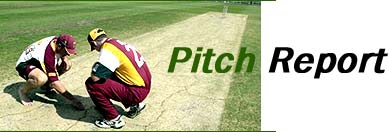Home > Cricket > Special >
Minimum machinery requirements
May 12, 2003

All grounds appeared to be well equipped with an array of rollers, good covers ad water absorbing rollers. Outfield mowing capacity needs to be increased in nearly every case. One mower needs to be used solely on the cricket square and practice block.
There will be a need for verti-cutting and scarifying equipment for the blocks and outfields, especially where hybrid Bermuda is planted and where pop-up irrigation is installed.
NZSTI is conscious of the risk of making inappropriate recommendations for purchasing mechanical equipment where manual methods are less expensive and just as effective. Our recommendations should therefore be considered provisional.
Recommendations
There is a good range of rollers up to 1.5 tonne per drum at every ground. I suggest that all grounds, particularly those using the black cotton soil (Type C) consider hiring a dual wheel 4 tonne roller (2 tonne per drum) for pre-season rolling of the new pitches (Appendix 10).
Alternatively, ballast could be added to the BCCI heavy roller to achieve the goal of 2 tonne per drum. (Appendix 14).
All grounds need a minimum of three walk behind outfield mowers (or a ride-on equivalent)plus a dedicated cricket square mower. (Appendix 1).
A specification for suitable mowers is given in Appendix 7.
The difference between verti-cutting and scarifying needs to be understood (appendix 8).
All cricket square mowing equipment must have a verti-cutting attachment.
It is optional whether outfield mowing equipment have verti-cutting attachments.
If the grounds can be heavily raked in wet conditions, then it may not be necessary to purchase motorised scarifying equipment (Appendix 12).
I suggest that motorised scarifying equipment will be essential for those grounds with hybrid Bermuda outfields and where outfields are irrigated and fertilized liberally.
They are most useful on cricket pitches where heavy scarifying is essential prior to soil topdressing. In my view, motorised scarifiers will be essential on all grounds sooner or later.
I recommend that all grounds should own a wheeled, hand-push centrifugal spreader for applying granular fertilizers (Appendix 9).
No grounds have boom sprayers for accurately applying pesticides to turf. All grounds use knapsack pressure sprayers with a single nozzle wand. Although there is some skill involved in properly calibrating a boom sprayer to accurately apply materials, especially herbicides, it is far more uniform than the knapsack sprayer. I therefore recommend that all grounds look to eventually purchase a boom sprayer over the next 2 years, provided training in accurate calibratio of a boom sprayer is also provided (Appendix 9).
It is likely that some grounds will require the use of soil decompaction or aeration equipment in the future. I was unable to identify any problems at the visit, so the need for such equipment could be identified on an individual basis in the future.
< Back | Next >
More Specials